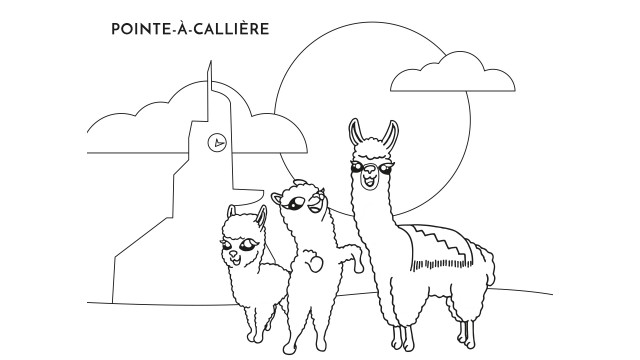Pointe-à-Callière at home
March 30th, 2020
The #IncaPeru exhibition differently
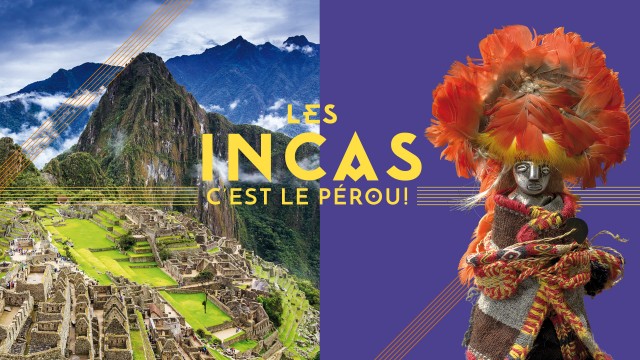
Since you’re unable to come see the exhibition The Incas, Treasures of Peru in person, we’re inviting you to explore certain aspects of Incan and Peruvian pre-Columbian cultures on video and through photos!
To start off, take a quick tour that gives you a glimpse of the various exhibition rooms!
#IncasPeru video
Watch our #IncasPeru videos, featuring our two experts: Samuel Moreau, Exhibitions Project Manager, and Hendrik Van Gijseghem, History and Archaeology Projects Manager, at Pointe-à-Callière.
- Paracas Culture: Hear about the Paracas people, who lived during the first millennium BCE and are well-known for their sites and extremely elaborate funerary rituals. We’ll explore a textile decorated with a feline pattern, dating to between 200 and 100 BCE.
- Nazca Culture: Learn more about Nazca culture, known for its famous and mysterious geoglyphs. You’ll see gold jewellery and learn about a technique used to tie-dye textiles.
- Moche Culture: Learn more about the Moche culture who had an extremely hierarchical society
- Wari Culture: This first expansionist empire and served as the military, political, societal, and ideological model for the Incas. Learn more about the sacredness of textiles and a particular weaving technique.
- Chimu Culture: The Chimù controlled one of the largest cities in the world in the 15th century, and built a complex system of irrigation canals to push back the desert. Discover some magnificent goldsmith pieces made of gold and silver.
- Our experts answer your questions: Our two specialists answered people’s questions about the exhibition The Incas, Treasures of Peru during a Facebook Live video. Make sure you don’t miss out on any future live videos by following us on Facebook!
An object, a story
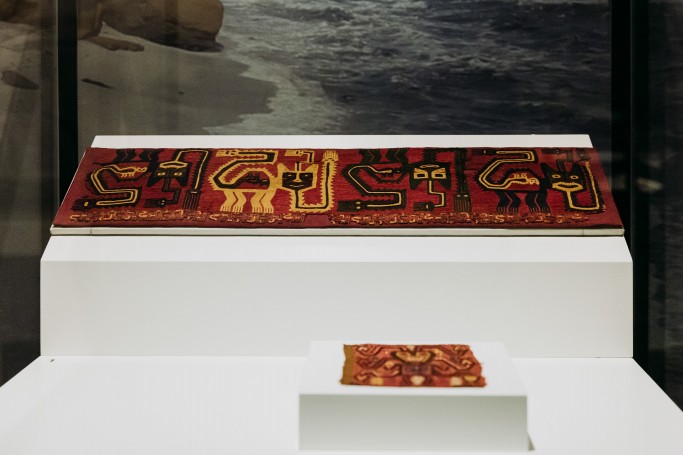
PARACAS
Mantle edging decorated with felines, an important theme in Andean history. The figure is reproduced with inverted colours. This dualism is central to Andean cosmology, in which everything exists solely as a complement to something else, equivalent but distinct.
Paracas-Nazca transition (200 BCE – 100 CE)
Camelid wool, cotton
20 x 71 cm
Mantle edging decorated with felines, an important theme in Andean history. The figure is reproduced with inverted colours. This dualism is central to Andean cosmology, in which everything exists solely as a complement to something else, equivalent but distinct.
Paracas-Nazca transition (200 BCE – 100 CE)
Camelid wool, cotton
20 x 71 cm
Royal Museums of Art and History, Brussels
Photo: Caroline Thibault
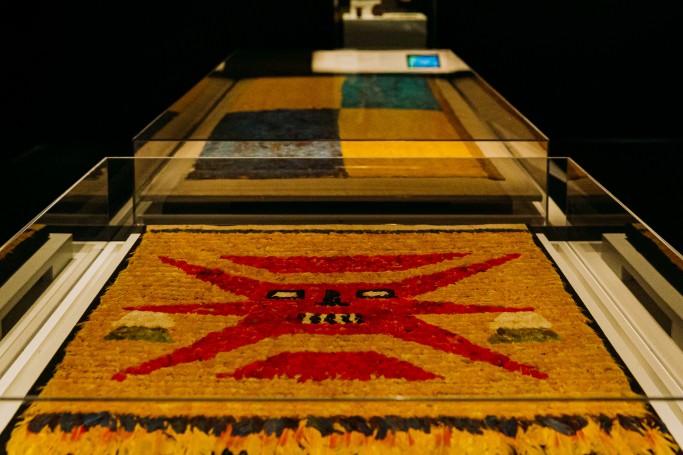
NAZCA
Front of a feathered tunicdepicting a face with six rays. The pink marks on yellow flight feathers are the result of tapirage, a colour alteration technique produced by controlling birds’ diet or by applying substances directly to their skin.
(100–600)
Feathers and cotton
102 x 80 cm
Front of a feathered tunicdepicting a face with six rays. The pink marks on yellow flight feathers are the result of tapirage, a colour alteration technique produced by controlling birds’ diet or by applying substances directly to their skin.
(100–600)
Feathers and cotton
102 x 80 cm
Private collection
Photo: Caroline Thibault
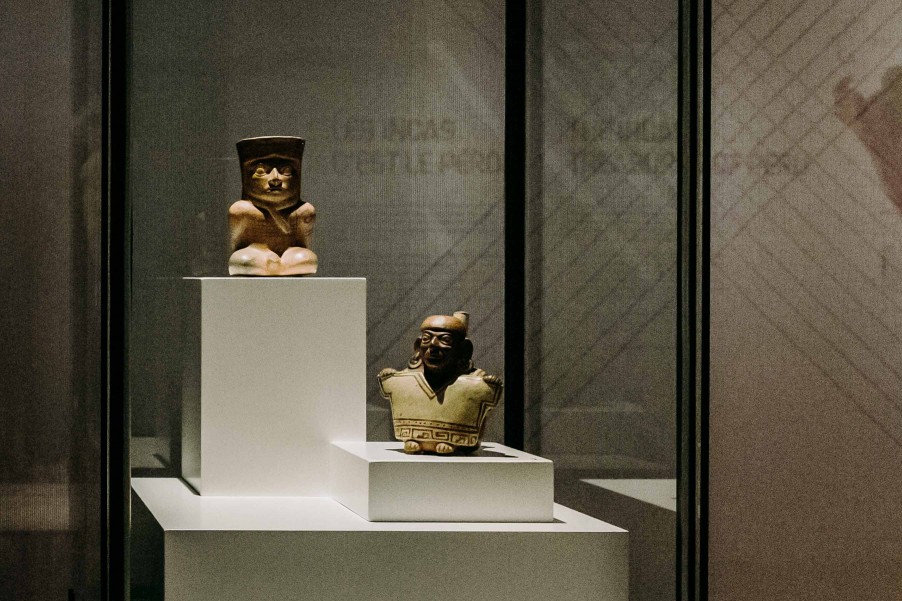
MOCHE
Vessel depicting an unclad prisoner. The lack of clothing indicates a subdued prisoner.
(100–600)
Terracotta
20.3 cm
Vessel depicting an unclad prisoner. The lack of clothing indicates a subdued prisoner.
(100–600)
Terracotta
20.3 cm
Royal Museums of Art and History, Brussels
Photo: Caroline Thibault
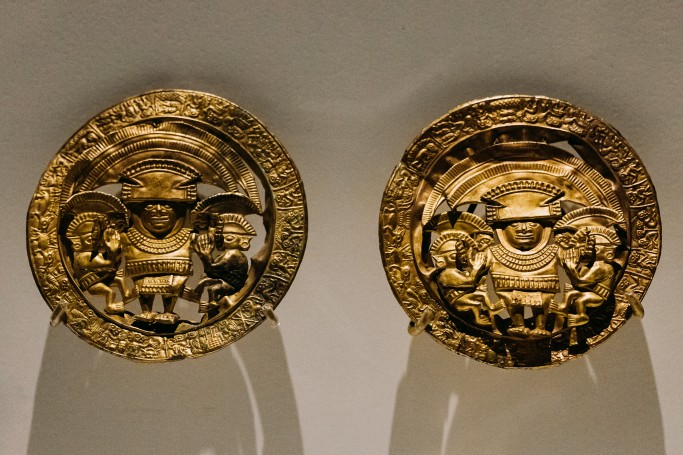
CHIMÚ
Ear ornaments. The Chimú were remarkable metalworkers. Their ornaments, such as this one, were worn by the nobility. Peru, northern coast (1100–1470)
Hammered and repoussé gold
8.6 cm
Ear ornaments. The Chimú were remarkable metalworkers. Their ornaments, such as this one, were worn by the nobility. Peru, northern coast (1100–1470)
Hammered and repoussé gold
8.6 cm
P. & D. Janssen-Arts Collection, Heritage Agency of the Flemish Community and the MAS, Antwerp
Photo: Caroline Thibault
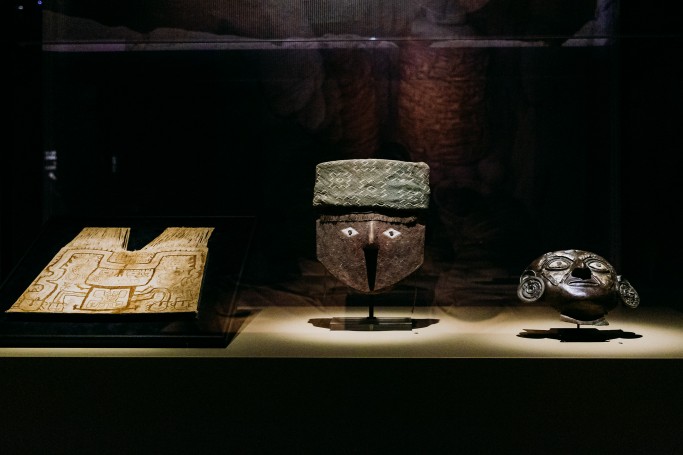
CHANCAY
False funerary head. The head and face were important in funerary rites. The deceased must be able to communicate, especially through speech, in the afterlife with their descendants on earth.
(1100–1450)
Wood and fabric
30 x 25 cm
False funerary head. The head and face were important in funerary rites. The deceased must be able to communicate, especially through speech, in the afterlife with their descendants on earth.
(1100–1450)
Wood and fabric
30 x 25 cm
Coenen Private Collection
Photo: Caroline Thibault
Photo: Caroline Thibault
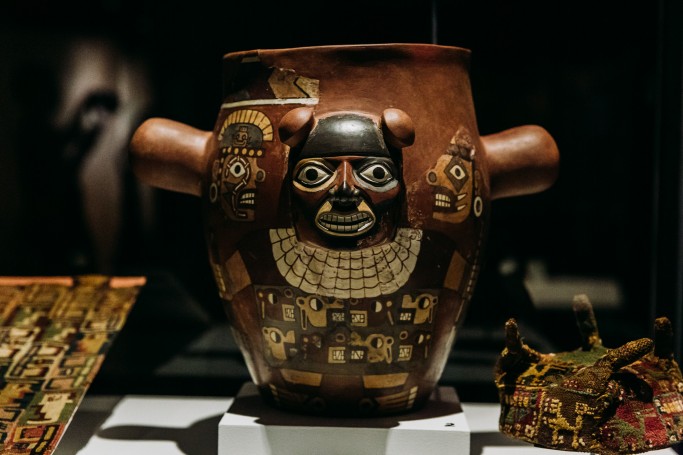
WARI
Vessel from Peru on which the Staff God wears a tunic decorated with feline heads and a necklace.
(600–900)
Terracotta
32 x 42 x 39 cm
Vessel from Peru on which the Staff God wears a tunic decorated with feline heads and a necklace.
(600–900)
Terracotta
32 x 42 x 39 cm
Linden-Museum Stuttgart
Photo: Caroline Thibault
Photo: Caroline Thibault
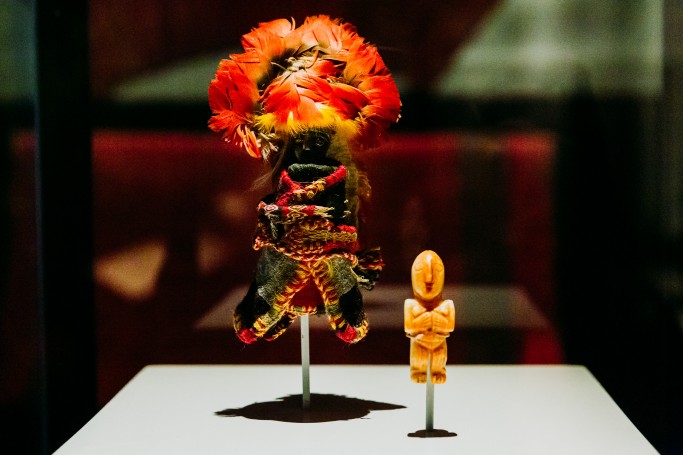
INCAS
Female figurine. Such gold or silver figurines symbolized the emperor or empress and were used as offerings during unusual events or natural disasters.
(1450–1532)
Silver, feathers, camelid wool, cotton
14 cm x 8.5
Female figurine. Such gold or silver figurines symbolized the emperor or empress and were used as offerings during unusual events or natural disasters.
(1450–1532)
Silver, feathers, camelid wool, cotton
14 cm x 8.5
P. & D. Janssen-Arts Collection, Heritage Agency of the Flemish Community and the MAS, Antwerp
Photo: Caroline Thibault
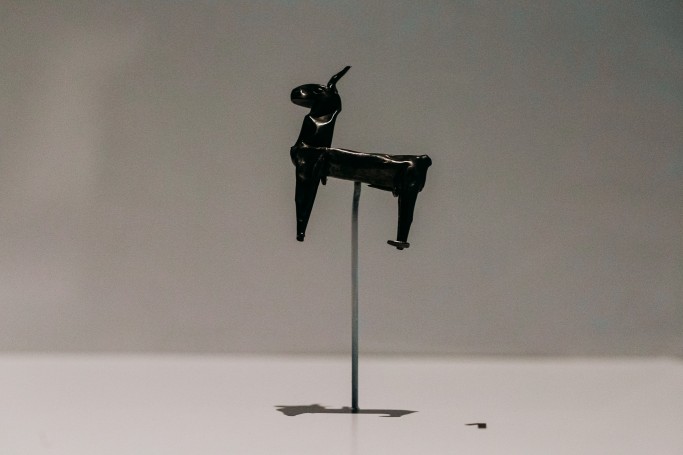
INCAS
Llama figurine used in a livestock-fertility ritual. Such offerings were among the funerary items placed in the graves of the elite.
(1450–1532)
Silver
6 x 4.6 x 1.3 cm
Llama figurine used in a livestock-fertility ritual. Such offerings were among the funerary items placed in the graves of the elite.
(1450–1532)
Silver
6 x 4.6 x 1.3 cm
Musée du quai Branly–Jacques Chirac
Photo: Caroline Thibault
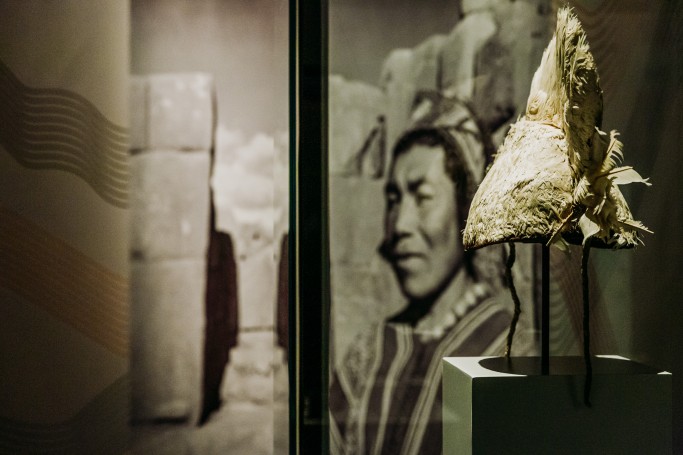
INCAS
Imperial feathered headdress
(1450 – 1532)
Feathers, plant fibres
34 x 55.5 cm
Imperial feathered headdress
(1450 – 1532)
Feathers, plant fibres
34 x 55.5 cm
Royal Museums of Art and History, Brussels
Photo: Caroline Thibault
Photo: Caroline Thibault
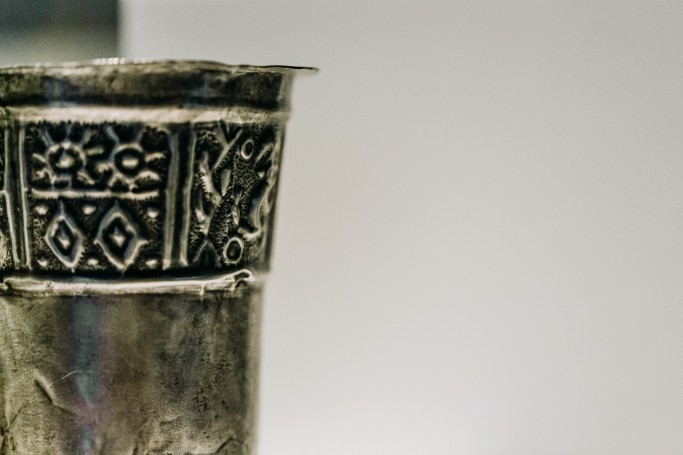
INCAS
Cup with zoomorphic decoration for chicha, the name the Spanish gave to the Incas’ corn beer. The Incas considered chicha a noble and magical drink that allowed them to communicate with the gods.
(1450–1532)
Hammered and repoussé silver
12.4 x 10.7 cm
Cup with zoomorphic decoration for chicha, the name the Spanish gave to the Incas’ corn beer. The Incas considered chicha a noble and magical drink that allowed them to communicate with the gods.
(1450–1532)
Hammered and repoussé silver
12.4 x 10.7 cm
Musée du quai Branly–Jacques Chirac
Photo: Caroline Thibault
Photo: Caroline Thibault
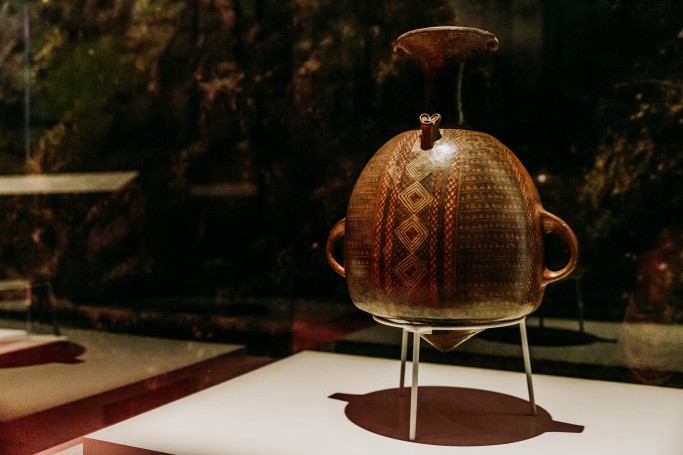
INCAS
The aryballos, or “Cusco bottle” was the most common form of Inca pottery. A sort of beer jar that was carried on the back and that had a new and unprecedented shape.
(1450–1532)
Terracotta
38 cm
The aryballos, or “Cusco bottle” was the most common form of Inca pottery. A sort of beer jar that was carried on the back and that had a new and unprecedented shape.
(1450–1532)
Terracotta
38 cm
Royal Museums of Art and History, Brussels
Photo: Caroline Thibault
Photo: Caroline Thibault
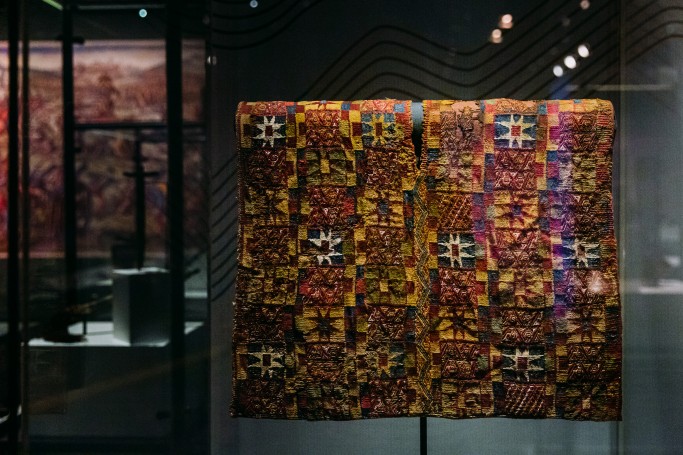
INCAS
Poncho (unku) made from a single piece.
(1450–1532)
Camelid wool, cotton
55 x 96 cm
Poncho (unku) made from a single piece.
(1450–1532)
Camelid wool, cotton
55 x 96 cm
Royal Museums of Art and History, Brussels
Photo: Caroline Thibault
Photo: Caroline Thibault










